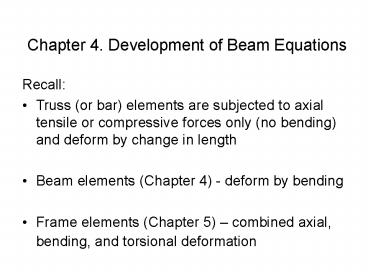Demo of a Commercial FEA Package - PowerPoint PPT Presentation
1 / 31
Title:
Demo of a Commercial FEA Package
Description:
Truss (or bar) elements are subjected to axial tensile or ... A Simple Example Cantilever Beam. Beam theory: FEA (single element): P. Timoshenko Beam Theory ... – PowerPoint PPT presentation
Number of Views:31
Avg rating:3.0/5.0
Title: Demo of a Commercial FEA Package
1
Chapter 4. Development of Beam Equations
- Recall
- Truss (or bar) elements are subjected to axial
tensile or compressive forces only (no bending)
and deform by change in length - Beam elements (Chapter 4) - deform by bending
- Frame elements (Chapter 5) combined axial,
bending, and torsional deformation
2
Typical problem
3
Review Beam Theory
M moment distribution E Youngs modulus
I Moment of Inertia of cross-section v
transverse displacement V shear load w
distributed load
4
Beam Theory (cont.)
- If EI constant and only concentrated loads and
moments are applied, i.e. w(x)0 - Solution (exact)
5
Beam Element - Definitions
6
Steps in the Finite Element Method
- Discretize the region and select element type
- Select a displacement function
- Define the strain/displacement and stress/strain
relations - Derive the element equations
- Direct Stiffness Method
- Energy Methods
- Method of Weighted Residuals (Galerkins method)
- Assemble global equations and impose boundary
conditions - Solve for unknown nodal displacements
- Solve for element strains and stresses
- Interpret results
7
Step 1 Select Element Type
- Beam Element
8
Sign ConventionsFEA formulation vs. Beam theory
9
Step 2 Select Displacement Function
Note
Which satisfies the governing differential
equation exactly if EI constant and only
concentrated loads and moments are applied.
Otherwise, the finite element solution is an
approximation.
10
Step 2 Select Displacement Function (cont.)
- Displacement parameters a1, a2, a3 and a4 have no
physical meaning - Rewrite displacement function in terms of nodal
displacements and rotations
11
Step 2 Select Displacement Function (cont.)
- Solve for ai, i 1,4
- Substitute into
12
Step 2 Select Displacement Function (cont.)
13
Step 2 Select Displacement Function (cont.)
Matrix form
14
Beam Element Interpolation Functions
- Matlab code to plot beam interpolation
functions - D. G. Taggart - Spring 2009
- close all clear all clc
- L1
- xlinspace(0,L,25)
- N1(2x.3-3x.2LL3)/L3
- N2(x.3L-2x.2L2xL3)/L3
- N3(-2x.33x.2L)/L3
- N4(x.3-x.2L)/L3
- subplot(2,2,1)
- plot(x,N1)
- title('N_1(x)')
- subplot(2,2,2)
- plot(x,N2)
- title('N_2(x)')
15
Step 3 Strain-displacement stress-strain
relations
- Kinematic assumption from beam theory plane
sections remain planar and normal to the
midplane - Strain displacement relation
- Moment displacement relation
- Shear force displacement relation (neglecting
shear deformation)
16
Step 3 Derive element equations (direct
approach)
- Recall
- Consider f1y and m1
17
Step 3 Derive element equations (cont.)
- Similarly for f2y and m2
- Matrix form
18
A Simple Example Cantilever Beam
- Beam theory
- FEA (single element)
- gt gt
19
Timoshenko Beam Theory (includes transverse
shear deformation)
- See text for derivation
- where
- (ksA) is the shear area and G is the shear modulus
20
Steps 5-8 Examples (several in text)Problem
4-2, p. 166
Note Could use symmetry, consider full model
first
21
Example 4-2 - Global Equations
BCs d1y ?1 d3y d5y ?5 0 Loads F2y
F4y -10,000 lb, M2 M3 M4 0 Need to solve
system of 5 equations
22
Example 4-2 (cont.)
Matlab Command Window output d -0.0480
-0.0000 0.0000 -0.0480 -0.0000
Matlab E30e6 I500 L1012 K(EI/L3)24
0 6L 0 0 0
8L3 2L2 0 0 6L
2L2 8L2 -6L 2L2 0
0 -6L2 24 0 0 0
2L2 0 8L2 F-10000 0 0
-10000 0 dK\F
Note ?2 ?3 ?4 0
23
Example 4-2 (cont.)
- Or, using symmetry
- ?2 ?3 ?4 0
- which yields
- Solving
- d2yd4y-.048 in
24
Example 4-2 (cont.)
- Third approach
25
Example 4-2 (cont.)
- Element loads and moments (element 1)
- Note equilibrium is satisfied
26
Beam Elements Distributed Loading
- Consider a beam with fixed supports subjected to
a uniform distributed load
27
Beam with fixed supports uniform distributed
load
For this statically indeterminate beam, it can be
shown that the reaction forces and moments
are Hence, we can replace the distributed
loading by an equivalent set of concentrated
forces and moments
28
Work equivalent forces moments
- Work done by distributed loads
29
Work done by distributed loads
30
Work equivalent concentrated forces and
moments(Appendix D)
31
Work equivalent concentrated forces and
moments(Appendix D cont.)































